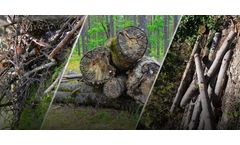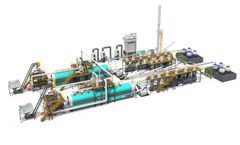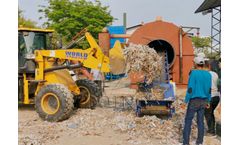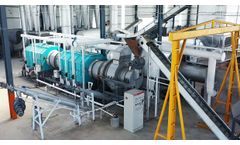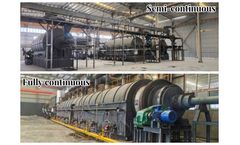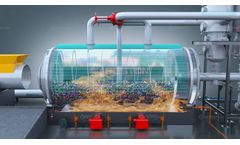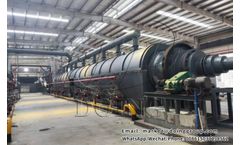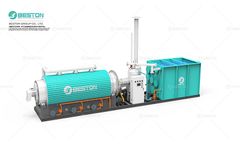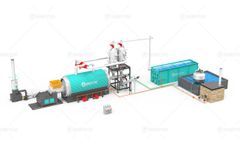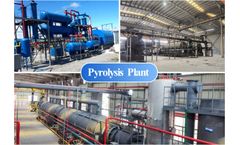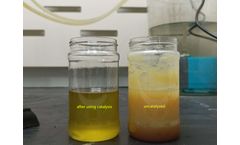Pyrolysis A Guide To Processing Articles & Analysis: Older
293 articles found
Charcoal production from forest waste represents an innovative approach to managing natural resources while addressing environmental and economic challenges. Through the integration of a charcoal making machine, this process offers a sustainable alternative to traditional practices, emphasizing resource efficiency and ecological preservation. Utilizing Forest Waste as a Resource Forest waste, ...
Pyrolysis is a thermal decomposition process that breaks down organic materials, such as plastic, rubber, and biomass, in the absence of oxygen. This process has gained significant attention for its potential in waste management and resource recovery, offering an effective way to convert waste into valuable products like fuel, gas, and biochar. A key question that often arises is whether ...
To recycle plastic to fuel oil using a pyrolysis vessel, follow these steps: 1. Preparation of Plastic Material: Collect and sort the plastic waste, ensuring it is free from contaminants that may interfere with the pyrolysis process. Common plastic types suitable for this process include polyethylene (PE), polypropylene (PP), and Polystyrene (PS) , ABS plastic, aluminum plastic, medical waste, ...
The operation of biochar production equipment involves a series of meticulously controlled processes that transform organic biomass into a valuable byproduct. Biochar, a stable form of carbon, is created through the thermochemical conversion of organic materials in the absence of oxygen, commonly referred to as pyrolysis. This process not only reduces waste but also yields a product that has ...
Setting up a continuous pyrolysis machine project involves a range of equipment and systems that work together to efficiently process waste materials (such as tires, plastics, rubber, medical waste, construction waste, e-waste, etc.) into useful by-products like fuel oil, carbon black, and syn-gas. Below is a comprehensive list of the equipment you will need to set up a continuous pyrolysis ...
The thermal efficiency of a pyrolysis reactor is a critical factor in determining the overall performance, energy consumption, and economic feasibility of the pyrolysis process. Pyrolysis, a thermochemical decomposition process, is used to convert organic materials such as plastics, rubber, and biomass into valuable products like oil, gas, and charcoal. The efficiency with which the reactor ...
With the growing urgency to find sustainable energy sources, plastic fuel oil, derived from waste plastic through pyrolysis, has emerged as a promising alternative. This oil offers an innovative way to convert non-recyclable plastics into usable fuel, contributing to waste management and energy production. But to fully appreciate its potential, it’s essential to explore the thermal ...
A continuous pyrolysis plant is designed to streamline the conversion of waste materials, such as plastics and tires, into valuable resources like fuel oil, carbon black, and syngas. Understanding its operating cycle time is essential for businesses and operators to achieve efficiency, maximize output, and make informed decisions about processing volumes, energy usage, and maintenance scheduling. ...
The biomass fraction of pyrolysis refers to the portion of biomass material that undergoes thermal decomposition in the pyrolysis process to produce valuable products such as biochar, bio-oil, and syngas. This fraction is significant in determining the efficiency and output of a pyrolysis system. Key Aspects of the Biomass Fraction in Pyrolysis 1. Composition: Biomass is primarily composed of ...
Sealing is a crucial factor in the overall performance and efficiency of a pyrolysis reactor. The technology behind pyrolysis revolves around the thermal decomposition of materials in the absence of oxygen. Any failure in sealing leads to oxygen infiltration, disrupting the pyrolysis process. This not only affects the quality of the end products but also poses serious safety risks. Understanding ...
Rice husks have long been regarded as agricultural waste. Through innovative carbonization machine, rice husks can be transformed into biochar, bringing new vitality to agriculture, energy, environmental protection and other fields. In the context of advocating green circular economy today, how to effectively utilize agricultural by-products and achieve sustainable use of resources has become ...
The mini pyrolysis plant represents a significant opportunity for investors looking to enter the waste-to-energy sector. By converting waste materials such as plastics, tires, and biomass into valuable by-products, mini pyrolysis plants offer a sustainable solution to waste management while generating potential revenue streams. Understanding the investment scenario for a mini pyrolysis plant ...
The pursuit of sustainable energy sources has intensified as the world grapples with the dual challenges of waste management and energy security. Plastic pyrolysis, a method of converting plastic waste into valuable fuels, has emerged as a significant alternative fuel production solution. This process addresses both environmental and energy concerns by transforming plastic waste into usable ...
Continuous pyrolysis is a complex process that requires specialized equipment. The journey from concept to operational equipment involves several stages: Design and Engineering: This phase includes detailed equipment design, material selection, process simulation, and safety considerations. Manufacturing: The actual construction of the equipment, involving fabrication, assembly, and testing. ...
In January 2014 BTG Bioliquids / Empyro BV started construction of its pyrolysis oil production facility in Hengelo, the Netherlands. The Empyro plant converts 5 tons per hour of wood residues into pyrolysis oil, process steam and electricity. Start-up of the installation commenced in early 2015 and production has gradually increased since. Nameplate capacity was reached in 2017 and since then ...
Pyrolysis is a transformative technology that can effectively process a wide range of waste materials, converting them into valuable products like fuel oil, carbon black, and gas. This article outlines the types of raw materials suitable for pyrolysis and describes the general process flow of a waste pyrolysis machine. 1. Types of Raw Materials for Pyrolysis (1)Waste Rubber Tires: Pyrolysis can ...
Beston Group has developed a cutting-edge catalytic pyrolysis technology that significantly enhances the efficiency and environmental friendliness of the process. By introducing catalysts into the reaction chamber, Beston's technology achieves several key benefits: Improved Oil Quality: Catalysts facilitate the breakdown of complex plastic molecules, resulting in higher-quality fuel oil with ...
This article provides a detailed guide on how to properly maintain a pyrolysis reactor, covering aspects from routine inspections to troubleshooting common issues. Understanding the Pyrolysis Reactor Before delving into maintenance practices, it is important to understand the key components of a pyrolysis reactor: Feedstock ...
Biomass pyrolysis stands at the forefront of innovative technologies aimed at mitigating environmental degradation. By transforming organic materials into valuable by-products, it offers a multifaceted approach to reducing carbon emissions. This process not only addresses the critical issue of waste management but also contributes significantly to sustainable energy production. Understanding ...
In the realm of sustainable agriculture and waste management, biochar has emerged as a versatile solution with numerous environmental benefits. The production of biochar, however, hinges on the quality and efficiency of the machinery used. Therefore, selecting an exemplary biochar machine manufacturer is critical to ensuring optimal performance and outcomes. This article delineates the essential ...

